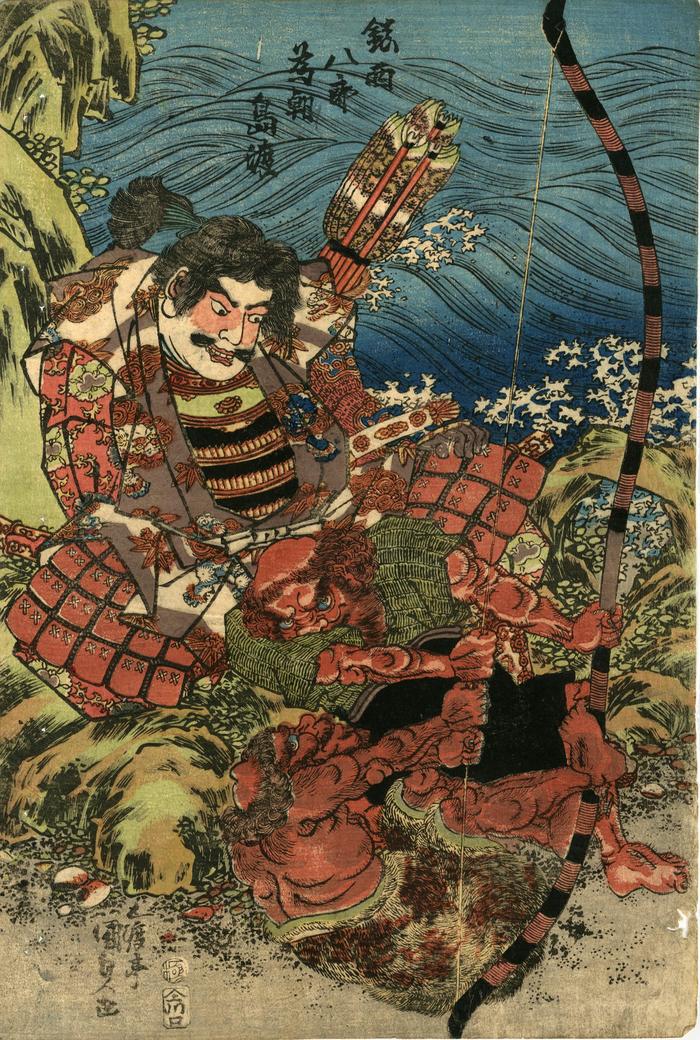Utagawa Kunisada (歌川国貞) / Toyokuni III (三代豊国) (artist 1786 – 01/12/1865)
Chinzei Hachirō Tametomo (鎮西八郎為朝) watching the demons trying to pull the string of his bow
ca 1820 – 1825
10 in x 14.5 in (Overall dimensions) Japanese woodblock print
Signed: Gototei Kunisada ga
五渡亭国貞画
Publisher: Kawaguchiya Uhei
(Marks 232 - seal 21-142
Seal: kiwame
British Museum - Hokusai painting from 1811
Waseda University - Hokusai book illustration
National Museum of Japanese History (via Ritsumeikan University) - a fresher copy that is somewhat larger on the left and top sides In Warriors of Old Japan and Other Stories, by Yei Theodora Ozaki, published in 1909 it says: "Long, long ago there lived in Japan a man named Hachiro Tametomo, who became famous as the most skilful archer in the whole of the realm at that time. Hachiro means "the eighth," and he was so called because he was the eighth son of his father, General Tameyoshi of the house of Minamoto. Yoshitomo, who afterwards became such a great figure in Japanese history, was his elder brother. Tametomo was therefore uncle to the Shogun Yoritomo and the hero Yoshitsune, of whom you will soon read. He belonged to an illustrious family indeed."
Tametomo was a remarkable youth who did not suffer fools easily. Because of this he once questioned the claims of one of the Taira emissaries. His impertinence led to his being exiled from his father's court. In many of the accounts of his exploits he ended up on the 'Island of Demons' - Onigashima, but remained undaunted. In time he gathered a followers. That was at this time that he acquired the name of Chinzei, which has been translated as 'the one who puts down the West.'
William Edmunds said that Chinzei Hachirō Tametomo meant "Tametomo, Eighth son, Conqueror of the West."
Tametomo had a number of encounters with demons and the stories morphed over the centuries. The futile efforts of the oni trying to pull the string of Tametomo's bow was popularized in print by Takizawa Bakin (1767-1848) and illustrated by his collaborator Hokusai in 1811. These were clearly the source of the Lyon Collection Kunisada print featured on this page.
It should be noted that Bakin was not always happy with the wonderful designs that Hokusai came up with to accompanying the stories he was telling. Pedro Thiago Ramos Bassoe in his 2018 doctoral thesis at the University of California, Berkeley, said on page 8: "Although one might imagine that the illustrations in yomihon were only a peripheral element of the text, and thus not a focus of the work’s literary production, the images in “reading books” were actually among the most finely-crafted woodblock prints of the Edo period. Take, for example, Hokusai’s artwork for Bakin’s A Dream under the Southern Bough: The Story of Sankatsu and Hanshichi (Sanshichi zenden Nanka no yume, 1807). Hokusai’s Chinese-inspired landscapes are finely detailed, displaying a level of technical precision that goes far beyond the average work of gesaku; they were, in fact, so successful that they caused a major rift between author and artist, with Bakin accusing Hokusai of ignoring his text and creating prints so lavish that they stole attention away from his story’s words. Nearly three decades later, Bakin continued to complain about the ubiquity of illustration in contemporary fiction, this time in a personal correspondence in which he claimed that it was still nearly impossible to publish any work of fiction without images. He lamented that readers had become incapable of enjoying books that included only text, thus causing them to remain ignorant of the excitement that could be offered by words alone."
****
If you look very closely at the armor that Tametomo is wearing you will notice that part of the fabric showing is displaying the sasarindō motif, an identifier of his particular part of the Minamoto clan.
****
The copy in the National Museum of Japanese History, which we have linked to, is not only brighter in its coloration, but more of the left-hand and top sides are shown. However, it also shows whole areas where on the color of the paper is apparent because those areas remained uninked. This is not the same with the example in the Lyon Collection which may have been somewhat trimmed to exclude those uninked areas.
warrior prints (musha-e - 武者絵) (genre)
Kawaguchiya Uhei (川口屋卯兵衛) (publisher)
Yūrei-zu (幽霊図 - ghosts demons monsters and spirits) (genre)
Tametomo (為朝) (role)
Tamenaga Shunsui I and II (為永春水) (author)
